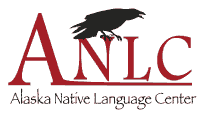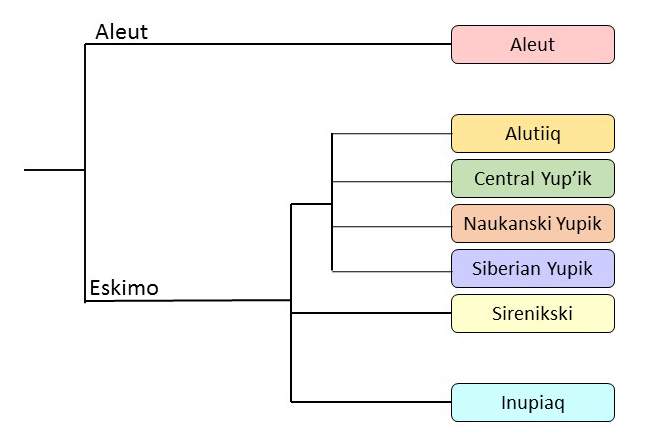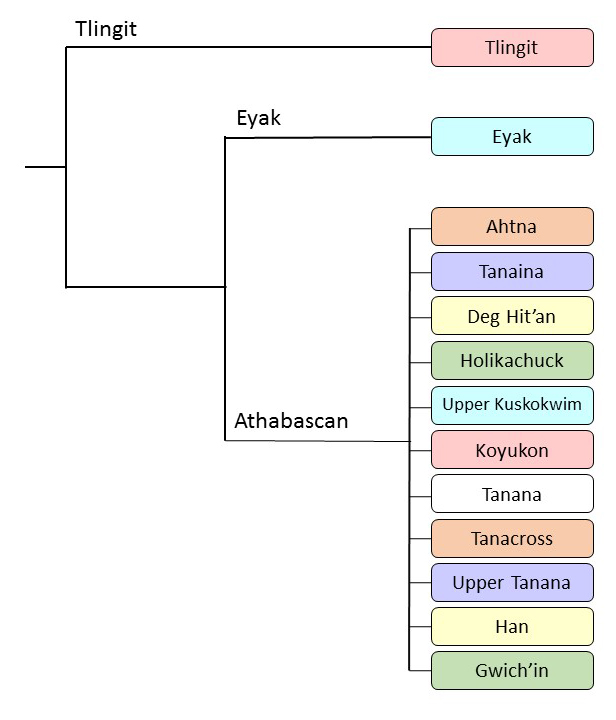Languages

Alaska Native Language Relationships and Family Trees
Language Relationships
By Gary Holton
Alaska is home to at least 20 Native languages belonging to four distinct language families. As the term implies, a language family is a group of languages descended from a common ancestor. Languages related in this way often share many resemblances, just as do people descended from a common ancestor. Of course, just as unrelated people may look alike, languages may be similar without being related through a common ancestor.
In Alaska it is relatively easy to distinguish language families. The difference between Inuit-Aleut and Athabascan-Eyak-Tlingit is immediately obvious even to the casual listener. First, the sound systems are very different. For example, AET languages all contain ejective, or popping, consonants, while Inuit-Aleut languages do not. Furthermore, the rules of word formation are completely different in the two families. Inuit-Aleut languages build words by adding suffixes to the right end of a word root, while AET languages build words by adding prefixes to the left end of word root. The Haida and Tsimshian languages are not related to either the Inuit-Aleut or AET families. Tsimshian is related to three other languages in Canada that together form the Tsimshianic family. Haida, though structurally quite similar to Tlingit, has not been demonstrably related to any other language family in the world. It is a language isolate.
Distinguishing between individual languages within a family of related languages is a much more difficult task. The crucial problem is deciding just how much of a difference justifies calling two speech varieties different languages rather than different dialects.
 |
Be aware that the words language and dialect are used in different ways by non-linguists. It is common for languages of low status to be referred to as “dialects,” while dialects of high status might be referred to as languages. Thus, you might hear about the “American language” (actually a dialect of English) or about the “Gwich’in dialect” (actually a distinct language with the Athabascan family). Language is power. |
Family Trees
Relationships between languages can be modeled in a way similar to human geneology using a family tree.
At the lower levels of the tree this model is imperfect for describing langs, as the effects of diffusion become more pronounced. This is particularly true of the Athabascan family, where multiple features have diffused across the family in different directions. Thus, it is not possible to say whether Tanacross is more closely related to Tanana or Han or Upper Tanana or Ahtna. Rather, Tanacross shares certain features with each of the neighboring languages.
A consensus family tree for Alaska languages is given below. Clicking on an individual language name in the graphic links to more detailed information about that language.
Language Maps
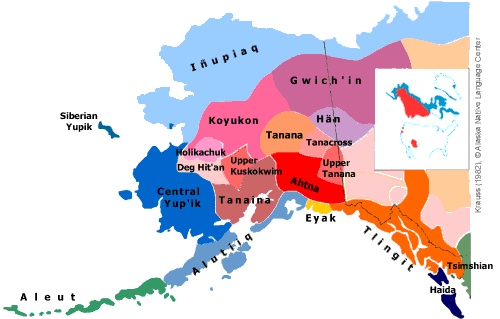 Language relationships are often represented on a language map. The standard map of
Alaska Native languages, Michael Krauss' Native Peoples and Languages of Alaska (1974,
revised 1982), shows language relationships as shades of colors.
Language relationships are often represented on a language map. The standard map of
Alaska Native languages, Michael Krauss' Native Peoples and Languages of Alaska (1974,
revised 1982), shows language relationships as shades of colors.
The languages of the Inuit-Aleut family are shades of blue, while the languages of the Athabascan family of are shades of red. Eyak and Tlingit are shaded toward yellow or brown, reflecting their status as more distant cousins of the Athabascan languages. Haida and Tsimshian receive completely different colors, relfecting the fact that they are not related to other languages in Alaska.
Notice that these colors are not rendered acurately in the various electronic versions of the maps (including the image above and the many imitations that proliferate across the internet). more...
Distant Language Relationships
Alaska is home to two of the world's major language families: Inuit-Aleut and Athabascan-Eyak-Tlingit (AET). For both of these families it is possible to use established linguistic methods to reconstruct an ancestral language, or proto-language, from which each of the languages is the family can be shown to descend through processes of regular sound change. The Comparative Inuit-Aleut Dictionary (ANLC Research Paper 9) provides information on proto-Inuit-Aleut, and the Comparative Athabascan Lexicon provides information on Proto-Athabascan and its relationship to Eyak and Tlingit. Both the Inuit-Aleut and the AET language families extend well beyond the borders of Alaska. The Inuit-Aleut family extends across the arctic from the Bering Straits to the east coast of Greenland. Athabascan languages range through western Canada and down into the US Pacific Northwest and desert Southwest. The origin, or homeland, of the Inuit-Aleut languages lies in the Bering Strait or Southwestern Alaska region. The homeland for the AET languages lies somewhere around the Alaska-Yukon border. But where did proto-Inuit-Aleut and proto-AET come from?
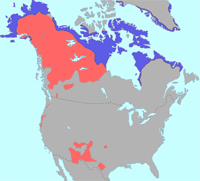 |
| Extent of the Inuit-Aleut (blue) and Athabascan-Eyak-Tlingit (red) language families. |
These are difficult questions to answer. While prehistoric populations often leave behind traces of their material culture which can be investigated using archaeological methods, we rarely find traces of prehistoric language. In Alaska there are no ancient manuscripts or clay tablets from which to infer information about prehistoric languages. Instead, we must resort to the methodology of historical linguistics, we seeks to reconstruct an ancestral form of the language by comparing existing modern forms. This methodology is well-established and extremely effective at relatively shallow time scales. But beyond a period of 5000 years or so the changes in language make it very difficult to infer much information about the proto-language. Unfortunately, the inapplicability of standard historical linguistic methods has led many to speculate as to possible long-distance relationships beyond Inuit-Aleut and AET.
 |
However, these proposals should be approached with caution and be treated as such.
That is, as proposals, not demonstrated facts. In an excellent 1988 review of the
subject, ANLC founder Michael Krauss concludes: "Though debate is as lively today as ever before, still no proof of genetic relationship of any native American language family to any Asiatic language family has yet been offered that satisfies even a majority of linguists who have carefully studied such subjects." [full article] |
Na-Dene
The most widely-cited proposal for a distant genetic relationship is that connecting AET and the Haida language. This proposal goes back at least to the 19th century, but it was first formulated with the label "Na-Dene" by Edward Sapir in 1915. The name comes from the word for na meaning 'person' in Haida and the word dene meaning 'person' in many Athabascan languages. (Note that Sapir did not include Eyak in his original Na-Dene proposal, though the relationship of Eyak to both Athabascan and Tlingit is now well-established.) Haida and AET share many typological features, including similar sound system and similar syntax. The greatest barrier to applying historical methodology to test this hypothesis has been that lack of accurate data. This issue has largely been addressed by the recent publication of the massive Haida Dictionary. Leading scholars have now been able to critical compare Haida with AET and have concluded that the data do not support the Na-Dene hypothesis. There is no proto-Na-Dene language. That is, Haida is not genetically related to AET.
Dene-Yeniseian
Many other distant relationships have been proposed for AET. One of the most well-researched proposals is that connecting Dene and Caucasian languages. Although much work has been undertaken to reconstruct the proto-Dene-Caucasian language, this proposal has never gained wide-spread support. However, one part of this proposal has recently received renewed attention through the work of linguist Edward Vajda on AET and Yeniseian languages. The so-called Dene-Yeniseic hypothesis connects the AET language family with Yeniseian, a small family of languages spoken in Siberia to the southwest of Lake Baikal. The most well-known of the Yeniseian languages is Ket, a highly endangered language with perhaps 200 speakers. The Dene-Yeniseian hypothesis was examined publically at a seminal symposium in Februrary 2008. While it will be some years before the proposal can be fully evaluated by scholars, many prominent experts in AET languages have received the proposal favorably (having soundly rejected previous proposals for distant genetic relationships). A post-symposium summary states that
"Vajda [has shown] that the abstract forms of lexical and grammatical morphemes and the rules of composition of the Ket verb find systematic and numerous parallels in the Na-Dene protolanguage reconstructed to account for the modern Tlingit and Eyak languages and the Athabaskan language family."
If confirmed, the Dene-Yeniseian would be the first new large language family to be establish in over fifty years, and the geographic extent of Dene-Yeniseian would be far larger than any other language family in world.
Beyond Inuit-Aleut
Many proposals have been offered to connect Inuit-Aleut languages with language families west of the Bering Strait. A connection between Greenlandic Inuit-Aleut and the Uralic languages was first proposaed in the 18th century. Over the years this proposal has been refined greatly. Another popular proposal is that connecting Inuit-Aleut with the Chukotkan languages of the Russian Far East. Neither of the hypotheses has been widely accepted within the mainstream linguistic community or by scholars at the Alaska Native Language Center. An excellent review of the these and other proposals can be found in Michael Fortescue's book Language Relations Across Bering Strait.
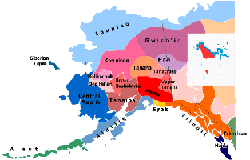 Learn More:
Learn More:
Alaska is home to at least twenty distinct indigenous languages. More than just dialectal variants, these different languages reflect the cultural heritage of Alaska's Native peoples. For more information about particular languages, click below.


